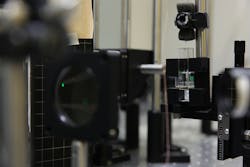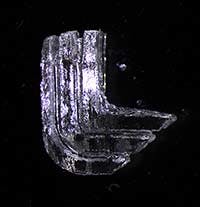Volumetric 3D Printing Injects Speed into Additive Manufacturing
Although additive manufacturing (AM), commonly known as 3D printing, lets engineers, scientists, and hobbyists alike build parts in configurations and designs never before possible, it is still a slow process unsuited to mass production. The layer-based technology can take up to hours or days to build three-dimensional parts, depending on their complexity.
However, researchers at Lawrence Livermore National Laboratory (LLNL), along with collaborators at UC Berkeley, the University of Rochester, and the Massachusetts Institute of Technology, have developed a method they have named volumetric printing that prints parts all at once. It uses laser-generated, hologram-like 3D images flashed into photosensitive resin from three different axes.
Each of the three laser beams define an object’s geometry from a different direction (x, y, or z), creating a 3D image suspended in the vat of resin. The laser light is relatively low in intensity, but where the three beams intersect, the intensity is enough to harden the photo-sensitive resin in about 10 sec. Excess resin is drained out of the vat, and researchers are left with a fully formed 3D part.
The LLNL logo created using the new volumetric 3D printing.
This approach, the scientists say, results in parts built many times faster than other polymer-based methods, and most (if not all) commercial AM methods used today. Due to its low cost, flexibility, speed, and geometric versatility, the researchers expect the framework to open a major new direction of research in rapid 3D printing.
“This is a demonstration of what the next generation of additive manufacturing may be,” says LLNL engineer Chris Spadaccini, head of Livermore Lab’s 3D printing effort. “Most 3D printing and additive manufacturing technologies consist of either a one-dimensional or two-dimensional unit operation. This moves fabrication to a fully 3D operation, which has not been done before. The potential impact on throughput could be enormous, and if you can do it well, you can still have a lot of complexity.”
With this process, the LLNL team has printed beams, planes, struts at arbitrary angles, lattices, and complex and uniquely curved objects. And although conventional 3D printing has difficulty with spanning structures that might sag without support, volumetric printing has no such constraints or need for supports. Another major advantage is that many curved surfaces can be produced without layering artifacts. This should reduce post-processing and make for smoother parts. Because volumetric printing does not involve layering, mechanical properties are more likely to be homogenous rather than based on the direction the layers were laid down.
The team also hopes the process can be accelerated by using higher-powered light sources. They also hope the process will work on extra-soft materials such as hydrogels to make parts which would otherwise be damaged or destroyed by fluid motion in traditional layer-by-layer printers. Volumetric 3D printing also is the only additive manufacturing technique that works better in zero gravity, expanding the possibility of space-based production.
The technique does have limitations, the researchers say. Because each laser beam propagates through space without changing, there are restrictions on part resolution and on the kinds of geometries that can be formed. Extremely complex structures would require lots of intersecting laser beams, which would limit the process, they explain.
Spadaccini adds that additional polymer chemistry and engineering also would be needed to improve the resin properties and fine-tune them to make better structures. “If you leave the laser on too long, it starts to cure everywhere, so there’s a timing game,” Spadaccini said. “A lot of the science and engineering is figuring out how long you can keep it on and at what intensity, and how that couples with the chemistry.”


